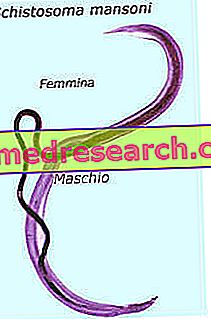Generality
What are white beans?
White beans is another way to call cannellini beans; it is therefore a botanical variety of the great species of beans ( Phaseolus vulgaris ).
Cannellini beans are not the only type of light bean cultivated by man; even those from Spain and some types of soy have the same shade.

Cannellini beans are typical Italian legumes widely used in traditional cuisine, especially in the Tuscany region and in central Italy in general. Fresh, frozen, dried and boiled or preserved in a jar, they are a popular ingredient for pasta dishes and side dishes.
From the dried seeds it is also possible to obtain a food flour, white bean flour.
Nutritional Properties
Nutritional characteristics of white beans
As anticipated, white beans are products of vegetable origin belonging to the IV fundamental group of foods.
Energy supply
They have a variable caloric intake depending on the state of preservation. Fresh raw or cooked provide a medium energy concentration. Generally, the total calories of these beans are lower than the refined cereals and more similar to those of the other fiber-rich starchy seeds. The energy content is mainly provided by carbohydrates, followed by proteins and a small amount of lipids.
macronutrients
Carbohydrates are mainly complex (starch), peptides of medium biological value and unsaturated lipids. Unlike those of cereals, these proteins are rich in lysine and poor in sulfur amino acids.
The fibers are abundant and cholesterol is absent.
micronutrients
As far as mineral salts are concerned, potassium, iron, phosphorus, manganese, calcium, zinc and selenium are more common. With regard to vitamins, on the other hand, there are good concentrations of some water-soluble belonging to group B such as thiamine B1, niacin PP, pantothenic acid B5 and pyridoxine B6. There is also a fair concentration of lecithins, phytosterols and other polyphenolic antioxidants.
White beans are free of gluten, lactose and histamine, but their proteins may be responsible for a specific allergy.
anti-nutritional factors
These legumes contain antinutritional factors such as phytic acid, oxalic and protease inhibitors. The first two are responsible for the chelation of certain important minerals, while the third group compromises the digestion and absorption of proteins. To eliminate these substances it is necessary to cook the food thoroughly (the dried seeds lose most of the phytates and oxalates during soaking).
Also noteworthy is the content of fasina, a toxic but also thermolabile compound, to which children are rather sensitive. It is therefore necessary to prevent the youngest from eating raw white beans.
in the diet
Cannellini beans lend themselves to most diets. They have no contraindications for obesity and metabolic disorders; on the contrary, thanks to the modest load and glycemic index (partly thanks to the abundance of fibers), they are ideal in the diet against overweight, type 2 diabetes mellitus and hypertriglyceridemia.
The presence of lecithins, phytosterols and other polyphenols, together with the abundance of fibers, act positively on lipid metabolism, reducing the intestinal absorption of fatty acids and cholesterol, and improving the profile of cholesterolemia.
Large amounts in the diet against oxalic acid kidney stones and against diarrhea or in case of malabsorption are not recommended.
White beans prevent and fight constipation effectively. They have no contraindications in vegetarian, vegan and religious diets (kosher, Muslim, Hindu etc). However, not being edible from raw, they must be avoided in the raw food diet.
The average portion of dried white beans, used as a first course, is 100 g (about 280 kcal). That of fresh raw white beans, frozen or boiled in a jar is about 3 times higher.
| Fagioli - Cannellini dried raw | Beans - Boiled dried cannellini beans | Fagioli - Cannellini cannellini drained | ||
| Edible part | 100% | 100% | 100% | |
| water | 10.0 g | 69.3 g | 76.7 g | |
| Protein | 23.4 g | 8.0 g | 6.0 g | |
| Lipids TOT | 1.6 g | 0.4 g | 0.6 g | |
| Saturated fatty acids | - g | - g | - g | |
| Monounsaturated fatty acids | - g | - g | - g | |
| Polyunsaturated fatty acids | - g | - g | - g | |
| Cholesterol | 0.0 mg | 0.0 mg | 0.0 mg | |
| TOT Carbohydrates | 45.5 g | 14.9 g | 12.5 g | |
| Starch | 42.6 g | 13.0 g | 11.1 g | |
| Soluble sugars | 2.9 g | 1.9 g | 0.3 g | |
| Dietary fiber | 17.6 g | 7.8 g | 4.8 g | |
| Soluble | 2.3 g | 1.1 g | 0.9 g | |
| Insoluble | 15.3 g | 6.8 g | 3.9 g | |
| Power | 279.0 kcal | 91.0 kcal | 76.0 kcal | |
| Sodium | 5.0 mg | 2.0 mg | 2.0 mg | |
| Potassium | 1411.0 mg | 289.0 mg | 431.0 mg | |
| Iron | 8.8 mg | 1.7 mg | 2.0 mg | |
| Football | 132.0 mg | 47.0 mg | 39.0 mg | |
| Phosphorus | 460.0 mg | 143.0 mg | 78.0 mg | |
| Magnesium | 170.0 mg | - mg | - mg | |
| Zinc | 3.6 mg | 1.54 mg | 0.68 mg | |
| Copper | 0.7 mg | 0.2 mg | 0.2 mg | |
| Selenium | - µg | - µg | - µg | |
| Thiamine | 0.30 mg | 0.10 mg | - mg | |
| Riboflavin | 0.06 mg | 0.01 mg | - mg | |
| Niacin | 3.0 mg | 0.6 mg | - mg | |
| Vitamin A | - µg | - µg | - µg | |
| C vitamin | tr | 0.0 mg | 0.0 mg | |
| Vitamin E | - mg | - mg | - mg | |
Kitchen
Gastronomic use of white beans
White beans can be used to make appetizers but above all pasta and side dishes. They lend themselves to any recipe, in any form of preservation, even if the most advisable product is always the fresh one. Raw cannellini beans are available in the summer season.
In the dried form, the white beans need a preventive period (6-10 hours) of soaking in cold water, necessary to rehydrate them as needed before cooking. The water, which would be better to change in the middle of the soak, must be eliminated, since it is rich in anti-nutritional elements. The most suitable cooking system is drowning (boiling) in a normal pot, with cold water and low heat, in which it can simply be boiled or stewed, alone or together with other ingredients.

Cannellini flour is very useful for making various types of dough. For example, with a percentage of around 10% it is possible to produce a very distinctive bread.
Description
The white beans are elongated, slightly curved and small (less than the borlotto). They have a uniform color, very clear but not white, more tending to a light brown. The surface is smooth.
Botany
Botanical outline on white beans
White beans are a botanical variety of the species Phaseolus vulgaris, belonging to the Fabaceae family, entirely imported from the New Continent after the discovery of America.
The cultivation of white beans begins in the first 3-4 months of the year, depending on the external climate and the possible use of seedbed. Plant growth lasts about 2.5-4 months, depending on the specific case, and harvesting takes place with a fully ripe pod.
White beans can develop fungal diseases (anthracosis, mildew, rottenness, etc.) or be attacked by parasites such as myrids, borers and gray flies.



